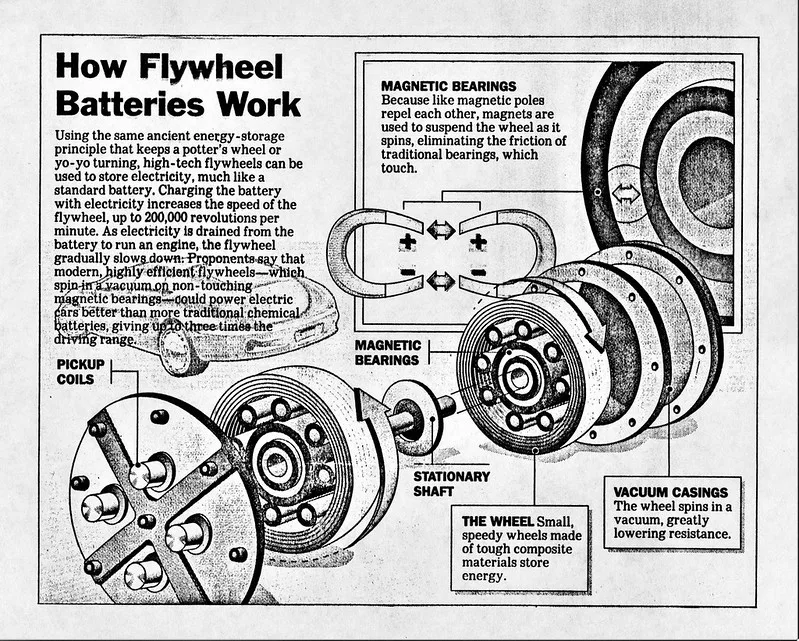Flywheels for sustainable future. Image credit: AFS20 Flywheel Batteries, 1994, Aiden Jewell, Flickr.
Joseph Lailey, a student at Sandringham School, is the overall winner of the 2023 Schools Science Writing Competition. You can read more about the winners and runners-up here.
The renewable energy sector has made significant progress in recent years and one humble device could bring us a step closer to an emission-free future.
Meet the flywheel—a rotating mechanical disk that can store and release energy on command. The flywheel draws input energy from an external electrical source, speeding up as it stores energy and slowing down as it discharges the accumulated energy. This is particularly useful in conjunction with renewable energy generation such as wind and solar power since optimal conditions fluctuate seasonally and even annually, making it difficult to supply year-round. By storing energy, we can save it for later use.
In fact, rudimentary flywheels have existed as a means of mechanical energy storage for thousands of years. The potter’s wheel quite literally kick-started their evolution. The turning platform could be connected by a long axle to a heavy flywheel at ground level, which allowed the potter to spin the platform using their foot, leaving both hands free to mould the clay. The next major development came with the industrial revolution; James Watt, an 18th-century Scottish engineer, saw the opportunity to implement this technology in steam engines. He created the sun and planet gear to convert the jolting reciprocating motion of steam-powered pistons into continuous rotational motion of the wheels, pioneering locomotive transport.
Meet the flywheel—a rotating mechanical disk that can store and release energy on command.
In 1953, the Gyrobus made its debut in Switzerland. Unlike traditional trams and buses, the Gyrobus was powered entirely by a 1.5 tonne flywheel that spun 3000 times per minute, with no need for an internal combustion engine or networks of overhead cables. Starting up the flywheel could take up to 40 minutes but once it was spinning it only needed to be recharged at stations with energy from the grid every few miles. This took no longer than 5 minutes, in which time passengers could be dropped off and picked up.
So why don’t we see these vehicles in our streets today? The idea was abandoned principally due to economic reasons; 3.3kWh of energy per kilometre for each bus was deemed simply unaffordable. Rough terrain led to wear and tear of the bearings, undermining performance, and safety was also called into question. Unsurprisingly, they were soon replaced by cheaper diesel-powered vehicles.
Nowadays it does seem ironic that the technology which led to such extensive burning of fossil fuels could help to reverse the effects of climate change. Only recently have flywheels been considered a viable option for electrical energy storage systems, with developments in materials and magnetic bearings reducing friction and maximising efficiency. The conservation of angular momentum means that rotational energy can be stored in these spinning objects (so long as no external torque is applied to the system). Increasing the rotating mass, optimising the shape of the flywheel or simply making it spin faster will increase the amount of energy stored.
Flywheel energy storage systems require little maintenance and can quickly respond to peaks in demand. Their performance is not affected by life, temperature or depth of discharge (the amount of energy the flywheel can release). Flywheels can also be easily manufactured from materials that are not harmful to the environment, unlike traditional chemical batteries.
With reusable rockets and the colonisation of Mars fast becoming a reality, the potential for flywheels beyond our home planet is immense.
With reusable rockets and the colonisation of Mars fast becoming a reality, the potential for flywheels beyond our home planet is immense. Martian bases would certainly rely on renewable sources of energy and durable energy storage systems could be all-important for survival.
Flywheels offer a promising alternative to chemical batteries which can be expensive to produce, are often made from rare metals and have shorter lifespans, with limits to how quickly they can store and release energy. These mechanical batteries are already helping to moderate spikes in the national grid and small portable flywheels are even being used in Formula 1, storing energy as the car brakes and supplying it back to the wheels when it needs to speed up again. As climate change becomes an ever more prevalent issue and energy demand continues to increase, environmentally friendly energy storage solutions like the flywheel will be key to a sustainable future.





